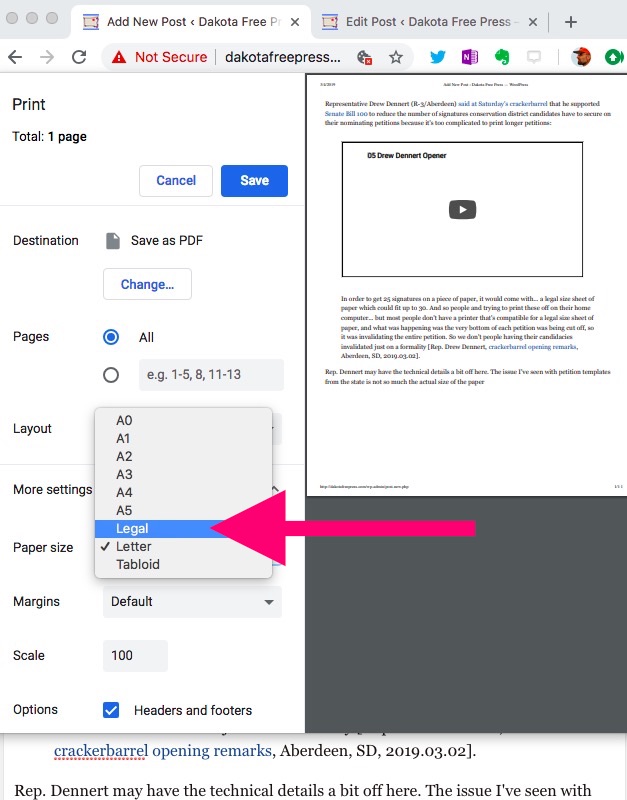Representative Drew Dennert (R-3/Aberdeen) said at Saturday’s crackerbarrel that he supported Senate Bill 100 to reduce the number of signatures conservation district candidates have to secure on their nominating petitions because it’s too complicated to print longer petitions:
In order to get 25 signatures on a piece of paper, it would come with… a legal size sheet of paper which could fit up to 30. And so people and trying to print these off on their home computer… but most people don’t have a printer that’s compatible for a legal size sheet of paper, and what was happening was the very bottom of each petition was being cut off, so it was invalidating the entire petition. So we don’t people having their candidacies invalidated just on a formality [Rep. Drew Dennert, crackerbarrel opening remarks, Aberdeen, SD, 2019.03.02].
Rep. Dennert may have the technical details a bit off here. Hit Ctrl+P or Command+P, and look for “Paper size” in your print settings:

Set your paper size to “Legal,” and your printer should know what to do.
The issue I’ve seen with petition templates from the Secretary of State is not that the paper is too big but that the margins on all petitions, letter or legal size, are set to a quarter inch, smaller than the print margin many printers require. That print margin causes bottom lines of petitions to be cut off and pose a risk of invalidation.
But don’t let me stand in the way of a Republican working hard to make circulating petitions easier. Given the Dennert Principle that a too-long petition sheet justifies reducing the number of signatures required to complete the petition, I would point out that many of the other petitions provided by the Secretary of State are that problematic size 8.5 inches by 14 inches, including ballot question petitions. Heck, to fit all the language the state requires me to print on my People Power Initiative Petition, I have to use an 11×17 sheet of paper printed front and back. Properly printing that document requires a lot of time and expense.
The Dennert Principle says that printing complications justify reducing the number of signatures a petitioner must collect by 40%. Senate Bill 100 is already on the Governor’s desk, but if he lives up to his Principle, Representative Dennert will grab a bill to hoghouse—perhaps HB 1094, which deals with circulating petitions and will require conference and another House vote if it survives the Senate this afternoon—and lower the number of signatures initiative and referendum supporters have to collect from 16,961 to 10,177.